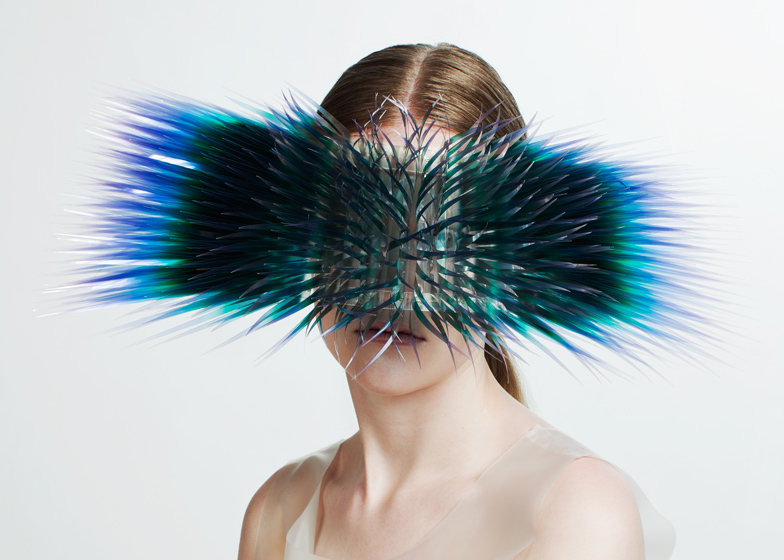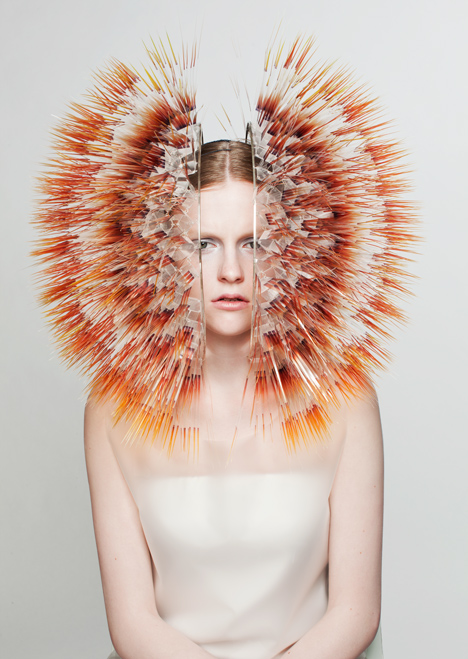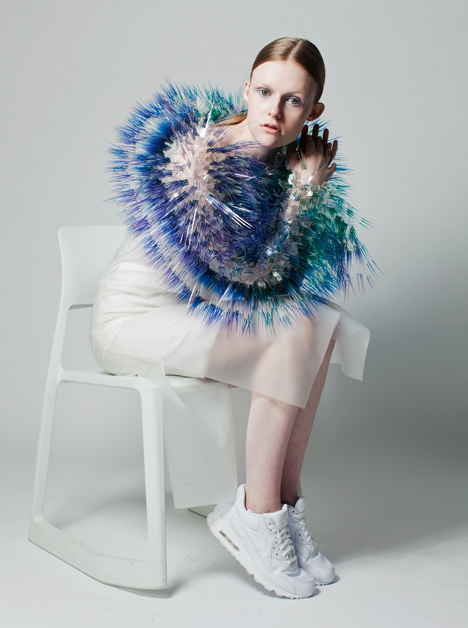20/08/2017
Mary Katrantzou
Great printing "technique" on the garments. I really love the result. I did not expect anything but seeing the garments printed but architecture "rooms" is really creative.
Another collection where I like the used geometry. It makes interesting illusion of a movement.
David Lachapelle - research point
I like how David works with light, with objects, there is a story, the composition. Everything is prepared to tell something, everything is placed well. The models are perfect, the world is a beauty, it is fashion which is expected to sell, so we need to get an illusion what is in today :-). I do like more the previous photographers somehow, I do not know why I am overloaded by information in David's works. Less is better. That is the reason I like the last photographs than others. The garments here are very "sexy" what more to say.
Sarah Moon - research point
Are the photographs really about a fashion? We can see a figure we can see a garment in the photographs. It is the use of blurriness and colours which make the photograph somehow like an impressionistic piece still catching my awareness. The garment in the first photograph looks like it can be wearable for special occasions, maybe as well the last one. The second and third looks like a fashion art without intention to wear it. Anyway these photographs are not usual we can see in magazines, I think.They are really great between the artificial styles in these days.
Richard Avedon - research point
I choose these pictures because of the movement and energy in them. They really capture your awareness. The question how the decisive moment was taken here. Everything is perfect, it is not only about fashion it is an art. I like how lights are used here, the contrast is high and we can see all details. All the garments are flexible. airy, folding in the movement. We can see the silhouette of bodies, all are Twiggy style of the 60s. Richard's sense of the figurative composition in a motion is just incredible. The photographs represent greatly the garments. It is appealing to buy one.
17/08/2017
16/08/2017
14/08/2017
Christian Boltanski - Personnes



ART or DESIGN: the textile is used as representation of something which wore someone, life form which is missing
TEMPORARY or PERMANENT
LARGE SCALE or SMALL SCALE
TRANSFORMING and/or DEFINING and/or FORMING
IMMERSIVE and/or DISTANT
PATTERN and/or COLOUR and/or REPETITION and/or SHAPE
You’ll see that, in addition to the garments, the noise of heartbeats permeates the
exhibition. Why do you think this might be?
It is a collection of heartbeats as Christian says in the interview https://www.youtube.com/watch?v=Lv7tatnhFAc&feature=youtu.be. The heartbeats when I was watching the clip were a little bit disturbing to me. I can imagine the atmosphere when walking there throughout the show. The heartbeats are like drums announcing the passing time in combination with the garments our path to the end - death.
To what extent are the textiles transformed into something other than fabric?
The textiles can represent death people and the squares their grave as it is described in https://www.theguardian.com/artanddesign/2010/jan/17/christian-boltanski-personnnes-paris-review. What is a story behind the textiles, who wore it, what happened to them, that would be questions which can appear in my mind? There is the hand of God which is lifting a group of garments to the roof to be immediately let to fall down. It is like a searching who can live or who can not, I just guess, heaven and hell.
What’s the significance of the installation title – and of the mechanical grabber?
Personnes - a French word for people and the same time nobody. Perfect title connection between the passed people an people visiting the show. The life form walking between garments with heartbeats reminding the mortality. The grabber is a process of chance to be alive or dead. Something else decides it.
What associations does this work conjure up in your mind?
The pile of garments remind me the piles in a concentration camp. The Holocaust. The wars. There is a feeling of a form of sorting systems. It is the grid, who decided what a piece will be there and there and why some are on the pile? Rasicms? Could be.
The wasting came to my mind as well but it was not mentioned in researched materials.
Marianne Straub
It was not easy to find more information about Straub moquettes. Anyway, there is a photo collection on London Transport web page but it does not work. Thanks to my fellow student Christy - Moved by Breath - she saved the photograph of the tube where we can see the art of Straub in its beauty inside the wagon.


ART or DESIGN: I think it is an art designed for a seat.
TEMPORARY or PERMANENT: Temporary till it needs to be changed.
LARGE SCALE or SMALL SCALE: It is evident if we approach to one seat it is a relatively small scale but when we see it as the whole piece in an empty bus and we calculate all vehicles we get a large scale.
TRANSFORMING and/or DEFINING and/or FORMING: Certainly the work transform the space, it makes it more vibrant and cosy.
IMMERSIVE and/or DISTANT: you can touch it when you are sitting on it or you can watch as a whole.
PATTERN and/or COLOUR and/or REPETITION and/or SHAPE
DENOTATION:
It is an upholstery. It is expected to be resistant to daily use for people sitting on every day in thousands of numbers. It is expected to be easily cleaning and to have a long life. It has nice combinations of blue and green dark colours and their shades.
CONNOTATION:
The pattern could represent somehow an order in the chaos around our lives. It put harmony when people are walking forth and back from tube to tube. The design of the pattern and its colour has a restful feeling. It must have had a great impact on the whole atmosphere when people were travelling. When I remember our bus interior 20 years ago it was shady not cosy space comparing with this great examaple of used textiles, its pattern and colour.


ART or DESIGN: I think it is an art designed for a seat.
TEMPORARY or PERMANENT: Temporary till it needs to be changed.
LARGE SCALE or SMALL SCALE: It is evident if we approach to one seat it is a relatively small scale but when we see it as the whole piece in an empty bus and we calculate all vehicles we get a large scale.
TRANSFORMING and/or DEFINING and/or FORMING: Certainly the work transform the space, it makes it more vibrant and cosy.
IMMERSIVE and/or DISTANT: you can touch it when you are sitting on it or you can watch as a whole.
PATTERN and/or COLOUR and/or REPETITION and/or SHAPE
DENOTATION:
It is an upholstery. It is expected to be resistant to daily use for people sitting on every day in thousands of numbers. It is expected to be easily cleaning and to have a long life. It has nice combinations of blue and green dark colours and their shades.
CONNOTATION:
The pattern could represent somehow an order in the chaos around our lives. It put harmony when people are walking forth and back from tube to tube. The design of the pattern and its colour has a restful feeling. It must have had a great impact on the whole atmosphere when people were travelling. When I remember our bus interior 20 years ago it was shady not cosy space comparing with this great examaple of used textiles, its pattern and colour.
13/08/2017
Research point - Wrapped trees
The wrapped trees" I do not really think that wrapping trees would be of my interest but the result viewed in photographs are really interested. It is the mood when sun shining through the fabric wrapped around the trees. The scenery captivated me a lot, space turned in something magical. On the second picture where the light changed the fabric into something metal, structured like a fractal is interesting as well.
The use of fabric is amazing and interesting. It must have been great to be there and see the work when was moving in wind weather, walking around and see it.
The use of fabric is amazing and interesting. It must have been great to be there and see the work when was moving in wind weather, walking around and see it.
Christo and Jeanne-Claude
It is amazing that someone can make such a large scale project. I do not see a reason to do it but it must be eye catching to see it in the space as it is The wrapped Reichstag piece. The running fence has great flexibility to move and make nice shapes when the wind blows. The scale of the projects is stunning. I love The Floating Piers, the extension of the streets is also stunning. Great work and I do not know why, because of the scale, because it is unusual because it is somehow magical. I love it.
http://www.christojeanneclaude.net/

http://archive.thefloatingpiers.com/completed
http://www.christojeanneclaude.net/

http://archive.thefloatingpiers.com/completed
Research point - Architectural uses of textiles
There are many examples how textiles have the influence to change a space into something interesting, fresh, appealing to explore it.
https://www.architonic.com/en/story/susanne-fritz-the-very-fabric-of-architecture-textile-use-in-construction/7000625
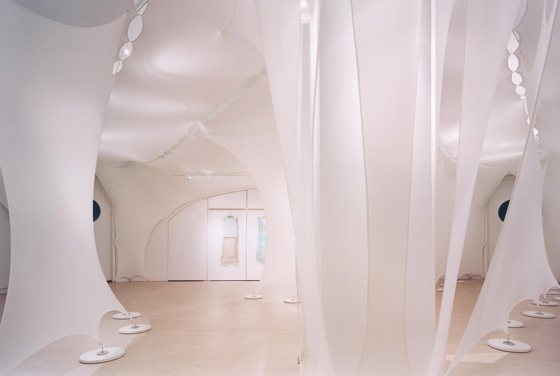
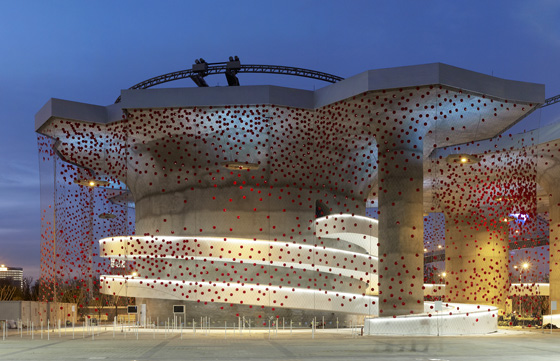
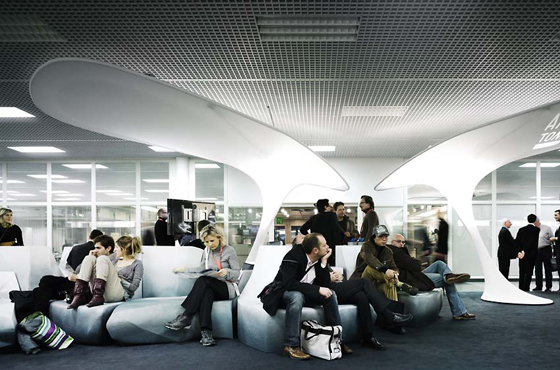
A house with a textile skin
http://www.archdaily.com/423832/passive-house-with-textile-skin-blaf-architecten
https://www.architonic.com/en/story/susanne-fritz-the-very-fabric-of-architecture-textile-use-in-construction/7000625



A house with a textile skin
http://www.archdaily.com/423832/passive-house-with-textile-skin-blaf-architecten
12/08/2017
Research point - Ptolemy Mann

What is her craft and how does she approach it in her work?
Ptolemy Mann is a weaver. She works with perfectly balanced colour and its combination. She is interested in architecture as well as in geometry. In her work, we can see variability of straight lines. The result is an amazing work which has a great effect on the audience. It is an abstract, dreamy, peaceful, beauty work.
Do they adhere to the ideas of Slow Design? To what extent does this allow them to
take risks, experiment and innovate?
It is her innovative approach to the dye process to get rich and vivid colours. 90% of her work is the dye process followed the weaving process. Her inspiration is from Bauhaus weaving pieces. The straight lines are dominant. The risk is that you can not just paint over the area you do not like it. What is weaved is fixed in the weaving process.
She wanted to spread the weaving art more into other levels of art. He produced many pieces in cooperation with other artists and still, she is open to doing further.
Is her story or the story of her work important? Why?
It is good to know how she grew up and what was her inspiration which leads to getting so beautiful Ptolemy's art. Somehow it is continuous weaving process from Bauhaus era and really I love it. I must have a piece of Ptolemy.
Do you value ‘craft’ and craftsmanship? Why or why not?
Certainly, I do value it. This course change maybe a little bit my mind or my point of view what the product/object is. The mass production can convey objects we need for living for reasonable prices. Every object has its own values but no one which is marked as hand-made can convey the additional experiences such as feeling it was produced by hands of the artist. The artist had it in his hands, we put into it a love, some intention to express unspeakable for example. No one can have the same piece, it is unique. When I thinking more and more about it I feel that it is maybe only a feature of us to possess something which other can not. A desire to have something beautiful, personal to our inner world, peaceful, strange, unique and what other else.
Is there room for craft in modern society?
No doubt, there will be always inquiry for the craft. I am the fun of the craft even some pieces are too expensive for me to buy.
06/08/2017
Part 4 Exercise 1
Do you believe there is a demand for hand-made objects and work? Why do you
think that some consumers seek out these qualities in the objects they buy?
I think there always was a desire to buy hand-made products, but it seems last years the demand is higher and higher. People have more freedom to produce something and sell it via the internet. Hand-made is popular in these days. It is luring our senses, and we see the object in different view comparing it with the mass-produced object. I love a knitted blanket which was produced by my wife. No mass produced sheet can have the personal quality. Hand made means to have something original, an object around it was the master - designer dancing around and spent a time to produce something special. And those qualities are appreciated and searched.
Do you think the desire for hand-made products is based on a romantic
perception of the hand-made and a sense of ‘post-industrial nostalgia for the
pre-industrial’? Why or why not?
Yes, the romantic side is significant. Without this feeling, there would be no desire to own something which connects us with an object - time, memories, place, love, etc. Mass production brings an object for the consumer in the cheapest version without the "romantic quality", we all know it was produced by machines. We can afford something which was very expensive in the pre-industrial era. We would like to have something special - hand made and be proud of it that we owner of a unique piece of something which we can use forever (furniture in my point of view).
Do you feel that hand-made products are viewed as luxury or value-added
products? How do hand-made items compare with mass-produced items, in
terms of their value, life cycle, cost and ethics?
There are hand made products which are a luxury as a Swiss hand made produced watches for example. On the other hand, there are products produce for fun, just because there is a desire to produce them, it can be a gift, it could be sold, the value is not only "quality", but it is a personal connection. Mass production can bring luxury as well as value, no doubt, I have a watch of my grand father, and they were mass produced, the value of them on the market is nothing but for me, the objects are viewed in personal quality, and it does not matter if it was handmade or mass produced. Life cycle depends on the type of the objects, some hand-made products such as soap will be here for a moment, some others such as furniture can be here for decades. The cost is a relative point of view. Some can calculate the price in time, and other can value design or the usable quality. Hand-mad products are expected to be pricier.
Reflect on any hand-made item you own (not necessarily textiles). Can you
remember why you were drawn to it? Did the fact that it was hand-made make
it feel ‘special’ or did you just buy it because you liked the design? How did its
price compare with the industrially-produced equivalent?
I bought a small carpet in Tunisia just to have a reminiscence of that place. This object was perfect for it. It is hand-made carpet with certification, and I choose small one because the price for me in that time was affordable. If I compare price the price with mass produced carpet I could get 10x bigger carpet but it is a reminiscence of the place, and it fulfils it very great. It is a special carpet in that point of view, and our cat loves it. We do not know why if it is the softness of the material. Who knows.
think that some consumers seek out these qualities in the objects they buy?
I think there always was a desire to buy hand-made products, but it seems last years the demand is higher and higher. People have more freedom to produce something and sell it via the internet. Hand-made is popular in these days. It is luring our senses, and we see the object in different view comparing it with the mass-produced object. I love a knitted blanket which was produced by my wife. No mass produced sheet can have the personal quality. Hand made means to have something original, an object around it was the master - designer dancing around and spent a time to produce something special. And those qualities are appreciated and searched.
Do you think the desire for hand-made products is based on a romantic
perception of the hand-made and a sense of ‘post-industrial nostalgia for the
pre-industrial’? Why or why not?
Yes, the romantic side is significant. Without this feeling, there would be no desire to own something which connects us with an object - time, memories, place, love, etc. Mass production brings an object for the consumer in the cheapest version without the "romantic quality", we all know it was produced by machines. We can afford something which was very expensive in the pre-industrial era. We would like to have something special - hand made and be proud of it that we owner of a unique piece of something which we can use forever (furniture in my point of view).
Do you feel that hand-made products are viewed as luxury or value-added
products? How do hand-made items compare with mass-produced items, in
terms of their value, life cycle, cost and ethics?
There are hand made products which are a luxury as a Swiss hand made produced watches for example. On the other hand, there are products produce for fun, just because there is a desire to produce them, it can be a gift, it could be sold, the value is not only "quality", but it is a personal connection. Mass production can bring luxury as well as value, no doubt, I have a watch of my grand father, and they were mass produced, the value of them on the market is nothing but for me, the objects are viewed in personal quality, and it does not matter if it was handmade or mass produced. Life cycle depends on the type of the objects, some hand-made products such as soap will be here for a moment, some others such as furniture can be here for decades. The cost is a relative point of view. Some can calculate the price in time, and other can value design or the usable quality. Hand-mad products are expected to be pricier.
Reflect on any hand-made item you own (not necessarily textiles). Can you
remember why you were drawn to it? Did the fact that it was hand-made make
it feel ‘special’ or did you just buy it because you liked the design? How did its
price compare with the industrially-produced equivalent?
I bought a small carpet in Tunisia just to have a reminiscence of that place. This object was perfect for it. It is hand-made carpet with certification, and I choose small one because the price for me in that time was affordable. If I compare price the price with mass produced carpet I could get 10x bigger carpet but it is a reminiscence of the place, and it fulfils it very great. It is a special carpet in that point of view, and our cat loves it. We do not know why if it is the softness of the material. Who knows.
23/07/2017
Research Point Slow Design
What are the guiding principles of this movement?
The slow design focuses on process, origin and materials while valuing the environment and the individual. It began in Italy in 1986 as a reaction against McDonald's fast food.
The principles are:
The slow design focuses on process, origin and materials while valuing the environment and the individual. It began in Italy in 1986 as a reaction against McDonald's fast food.
The principles are:
- REVEAL: reveal experiences in everyday life which are missed or forgotten, including the materials and processes that can be easily overlooked in an artifact's existence or creation. (Slow perspectives and practices in virtual experiments - The night journey)
- EXPAND: consider the real and potential "expressions" of artifacts and environments beyond their perceived functionalities, physical attributes and lifespans. (Changes in energy behaviour Ramia Mazé, Intimacy and interdependence with the objects around us Monika Hoinkis, reducing power to facilitate slowness Olivier Peyricot)
- REFLECT: SlowLab has coined 'reflective consumption'. Simon Heijdens believes that design should, like nature, unleash a continuum of expressions over time.
- ENGAGE: Slow design processes are open-source and collaborative. Human chair by Martin Ruiz de Azua
- PARTICIPATE: The slow design encourages users to become active participants in the design process, embracing ideas of conviviality and exchange to foster social accountability and enhance communities.
- EVOLVE: The slow design recognises that richer experiences can emerge from the dynamic maturation of artifacts, environments and systems over time. Edible estate / landscape
09/07/2017
08/07/2017
02/07/2017
Textiles Exercise 1
How would you define 'sustainability'?
If the textile production is one of the most polluting industries in the world, their life cycle must be taken into consideration. There are products which have a shorter life than others such as a carpet cold have a longer life than a fashion shirt. Producers, as well as designers, end users, must be responsible according to waste management. Re-using raw materials, their recycling is in focus for decades. For example, plastics (polyester, polypropylene) are recycled/reused for the nonwoven industry of filters, diapers, geotextiles. The consumption in the balance of recycling.
Sustainability:
Sustainability in production and consumption of textiles:
If the textile production is one of the most polluting industries in the world, their life cycle must be taken into consideration. There are products which have a shorter life than others such as a carpet cold have a longer life than a fashion shirt. Producers, as well as designers, end users, must be responsible according to waste management. Re-using raw materials, their recycling is in focus for decades. For example, plastics (polyester, polypropylene) are recycled/reused for the nonwoven industry of filters, diapers, geotextiles. The consumption in the balance of recycling.
Sustainability:
- Bussines/Industry: the western culture is based on consumption. The automotive industry is an example where everlasting sustainability keeps them in sales numbers. How we will deal with continuous consumption?
- Environment: the focus on 'green' policy to not pollute Earth.
- Resources: Sustainability to exploit alternative energy
- Food waste change
- Recyclate materials
Sustainability in production and consumption of textiles:
- Raw material. Land and water used for grow natural fibres. Fossil extraction for synthetic fibres.
- Production: energy and waste management, added chemicals, questions about workers/customers safety issues,
- Use/ consumption: durability and stability, longevity issue, recyclization, treatments issue
01/07/2017
Assignment 4
It was great to analyse Michals Duane's work. This assignment changed my understanding how the ambiguity of a work can be changed when we add more information. I have never realised how a still image in a film can be a powerful tool to let the audience in uncertainty.
Assignment 4
Tutor's feedback
Tutor recommended me to rework the assignment. I made some changed in the introduction and polished some sentences.
Assignment 4 reworked
Assignment 4
Tutor's feedback
Tutor recommended me to rework the assignment. I made some changed in the introduction and polished some sentences.
Assignment 4 reworked
07/05/2017
Exercise 3 Photography
Derek Trillo, The Cheshire Plain Beeston Castle
A photograph was taken from Beeston Castle. It took some time to find the place on Google maps, but I found it. It is interesting to see the place from above and from the street. The view is completely different of course. I was always amazed how our mind built maps which we use for orientation. Our mental maps are different than the "real" maps. I know the moment when mind comparing its mental map with a geographical map. A moment of WOW I had completely another idea how it should look the map. As a child I tried to draw a map from my memory, I was satisfied, but it was entirely different from the real.
The ground level photographs look like a different place, we do not see the same details. We are not able to recognise the lines, the small "wood".
The same situation is in the second photograph. The view from a high attitude gives us a lot of information, we can see more building, more roads. Seeing the same place from the ground level we get a different image of the place, more details of closest objects. Seeing it from above we can get the structure of the town divided by roads for example.
John Davies, Agecroft Power Station, Salford, 1983
I really like the photograph. Without spending some time I would certainly overlook the details here, like the football match or training, the horse on the left corner. We can see those information thanks to the elevated viewpoint otherwise we could not. If we have a closer photograph of the towers we could not see the football players. The towers would be out of its context. Great example how to introduce an object into the place it is. The effect of being able to see the football game in the shadow of the towers is somehow surreal, the connection between pleasure and current technology in that time. It reminds me, Julian Verne's stories. Really big objects - towers and small creatures playing the game.
A photograph was taken from Beeston Castle. It took some time to find the place on Google maps, but I found it. It is interesting to see the place from above and from the street. The view is completely different of course. I was always amazed how our mind built maps which we use for orientation. Our mental maps are different than the "real" maps. I know the moment when mind comparing its mental map with a geographical map. A moment of WOW I had completely another idea how it should look the map. As a child I tried to draw a map from my memory, I was satisfied, but it was entirely different from the real.
The ground level photographs look like a different place, we do not see the same details. We are not able to recognise the lines, the small "wood".
The same situation is in the second photograph. The view from a high attitude gives us a lot of information, we can see more building, more roads. Seeing the same place from the ground level we get a different image of the place, more details of closest objects. Seeing it from above we can get the structure of the town divided by roads for example.
John Davies, Agecroft Power Station, Salford, 1983
I really like the photograph. Without spending some time I would certainly overlook the details here, like the football match or training, the horse on the left corner. We can see those information thanks to the elevated viewpoint otherwise we could not. If we have a closer photograph of the towers we could not see the football players. The towers would be out of its context. Great example how to introduce an object into the place it is. The effect of being able to see the football game in the shadow of the towers is somehow surreal, the connection between pleasure and current technology in that time. It reminds me, Julian Verne's stories. Really big objects - towers and small creatures playing the game.
Subscribe to:
Posts (Atom)
































